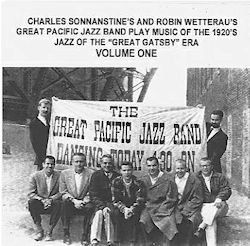 BUY NOW AmazonUK AmazonUS |
Jazz of the “Great Gatsby Era” vols. 1& 2
|
Vol 1 (MMRC-CD-52) Playing time: 50m 59s
Messin’ Around; Daddy Do; Mandy Lee Blues; Big Bear Stomp; All Night Blues; Tears; Moonshine Blues; Sidewalk Blues; Krooked Blues; Don’t Forget to Mess Around When You Do the Charleston; Annie Street Rock; I’m Leaving This Morning; Mabel’s Dream; Lord, Send Me a Man; 1919 Rag .
Vol. 2 (MMRC-CD-53) Playing time: 44m. 35s
The Chant; Gulf Coast Blues*; Doin’ the Hambone; Over in the Gloryland; Great Pacific Stomps; All Night Blues; Minstrels of Annie Street; Friendless Blues; Sic ‘em Tige; Southern Stomps; Jingles; At a Georgia Camp Meeting; Jelly Bean Blues; Copenhagen .
Charles Sonnanstine, cornet, co-leader, vocal*; Birch Smith/Frank Goulette, cornet; Sanford Newbauer, trombone; Roy Giomi, clarinet; Robin Wetterau, piano, co-leader; Bill Carpender, tuba; Tito Patri and Lee Valencia, banjos; Lloyd Byassee, drums.
Both volumes recorded at the same performance at Muir Beach, California, ca. 1957.
The Great Pacific Jazz Band was formed in California in 1958 by two transplants from the Dixieland Rhythm Kings of Ohio: Charles Sonnanstine and Robin Wetterau. Several of the Great Pacific Jazz Band also were members at one time or another of the Bay City Jazz Band—Newbauer, Giomi, Patri, Valencia, and Byassee—and both bands were well-known in the San Francisco Bay Area. However, only the Bay City Band was professionally recorded (on the Good Time Jazz label) and neither band toured; so the chances were slim that either was known much outside of California. But they did enjoy some renown in the immediate Bay Area.
Like most traditional jazz bands on the West Coast, the Great Pacific Jazz Band descended musically from the Lu Watters Yerba Buena Jazz Band, in which the brass predominated with half the members playing a brass instrument. (In turn the YBJB was modeled on King Oliver’s Creole Jazz Band, but having the tuba rather than the string bass.) Virtually all of the tunes on these two discs are also to be found in the YBJB’s repertoire, further cementing the lineage, and as in the Watters band, they are given a “brassy” treatment here, too. A few are Watters’ compositions, such as Annie Street Rock and Big Bear Stomp on vol. 1. However, despite all of that together with having the same instrumentation, this band will not be mistaken for the Watters’ group. There is a fire, an eagerness to the latter that is missing here, which is not to say that the Great Pacific Jazz Band is not a very good band—it is, but it does not seem to express the same passion as the Yerba Buena Jazz Band.
Perhaps the quality of the sound contributes to that difference. It is not professional, being fairly uneven: the volume level varies from track to track, and there is a muddiness overall—no clear definition of instruments. The balance is questionable, with the bass drum tending to be over-recorded and the clarinet often under-recorded. The sole vocal that I was able to detect (regrettably there are no liner notes on my copy), that on Gulf Coast Blues, was almost totally inaudible, due also in large part to being off-mike.
All of that is rather unfortunate because this was a very good band which, on this its only released recording, deserved better. It does not try to recreate the YBJB, other than perhaps on Doin’ the Hambone, employing its own arrangements and motifs. Other tunes have the stamp of the GPJB. On volume 1, Krooked Blues features interesting double-time choruses and coda; the hokum is absent on Sidewalk Blues ; Mable’s Dream is taken at a spanking tempo, unusual for this tune; and I’m Leaving This Morning, that fine Ma Rainey number, has some beautiful two-cornet breaks. On volume 2, Minstrels of Annie Street, a Turk Murphy composition, features Newbauer’s trombone, but his breaks are quite different from Murphy’s, although his tone and attack resemble Murphy’s, as did those of many of the Bay Area’s trombonists; differing from many other renditions, Jelly Bean Blues ends on a minor chord; and Jingles, not recorded by Watters, is rather strange, especially with its “surprise” ending—one which seemed to surprise the musicians, too! These were a few of the moments that impressed me.
All of the tracks, however, have that two-beat rhythm and that brassy sound so characteristic of West Coast traditional jazz. It is good to have this recorded memento of the Great Pacific Jazz Band available. The CD set, despite its shortcomings, assures that the band will not be lost to posterity. It also provides some 95 minutes of good traditional jazz.
Merry Makers records are available at several on-line outlets, such as cdUniverse and Amazon, and from City Hall Records, 101 Glacier Point, Suite C, San Rafael, CA 94901, tel. 415-457-9080.
Note : This band is not to be confused with a later band of the same name, Great Pacific Jazz Band (1979-1995) of Southern California led by Bob Ringwald.
Bert Thompson